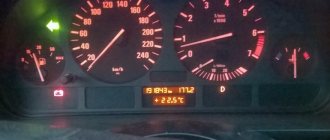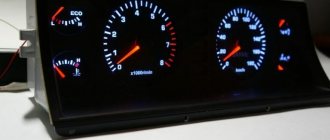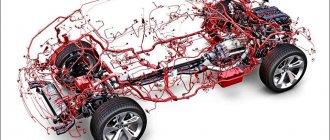The dashboards of classic domestic cars are not highly informative. There is nothing superfluous on them, except for indicators of the operation of the main engine systems, but they are quite enough so that the driver is informed in time about possible malfunctions of the car. However, it happens that some device fails, and then it becomes impossible to determine the failure at its initial stage.
In this article we will talk about the case when the battery charging light is constantly on, using the example of the popular classic cars VAZ 2106 and 2107. We will look at the main reasons for this phenomenon, and also try to diagnose and eliminate possible faults.
Why do you need a battery charging warning light?
In order for the driver to monitor the charging status of the battery, there is a voltmeter with a scale on the instrument panel, as well as a small red window under which a warning light is installed. When we insert the ignition key and turn it in the lock one turn, this lamp turns on and lights up red. The voltmeter needle is in the zero position. This means that the generator is at rest and does not charge the battery. When the engine starts, the lamp should go out and the instrument needle should move to the right, indicating the amount of voltage supplied to the battery. This happens when the machine’s power supply system is fully operational. But if the VAZ 2107 or 2106 battery charging light is on even after the engine is started, most likely there is a failure somewhere. And our task is to find its cause and eliminate it.
If the battery charge light comes on while on the road
You are driving quietly and not bothering anyone, when in the most unexpected way (as always, however), the battery icon on the panel lights up in red. This is a signal that your car’s generator is faulty and has stopped providing current for recharging, so that all electrics now “sit” only on the battery.
What we may encounter in this case:
- The generator belt has broken. Electricity is generated during the rotation of the generator axis. This axis is driven by a belt. So if the belt breaks, the generator shaft stops rotating and the generation of electricity stops. And this leads to the battery charge lamp on the dashboard coming on.
- The voltage stabilizer on the generator has failed. Everything is simple here. The part is covered with a copper basin, and again we are not receiving the required voltage to the battery. The issue is resolved by replacing the failed element.
- Severe wear on the generator brushes. The generator shaft is equipped with graphite brushes that help generate electricity. Over time, they can wear out greatly, which will lead to a decrease in the electricity generated and the red battery icon on the device will light up. It is also necessary to replace worn components with new ones.
The list of possible reasons is, of course, not entirely complete. The most critical ones are given. Sometimes there may also be problems with diodes, oxidized terminals and contacts, problems with the fuse or ground wire contact.
Design of generators on VAZ cars
What can a constantly burning battery charging lamp indicate?
If the battery charging light is on in a VAZ 2107 or VAZ 2106, there can be only one reason - the battery is not receiving voltage from the generator, or is receiving it, but its value is insufficient. There may be several malfunctions that lead to this:
- violation of normal contact at the battery terminals;
- loose tension or damage to the alternator belt;
- lack of contact of its “negative” terminal with “ground”;
- break in the rotor excitation circuit or wear of the generator brushes;
- diode bridge malfunction.
- defective fuse;
- failure of the relay regulator.
Before starting diagnostics
An important point in deciding why the VAZ 2107 or 2106 battery charging light is on is the very fact that voltage is supplied to the battery from the generator. In other words, if it does not reach the battery at all, there is nothing to be surprised about. The lamp must light in such a situation. But if the battery charging light is on, but there is charging, it will be a little more difficult to solve this problem.
Our first priority is to determine whether voltage is supplied to the battery. This is not at all difficult to do, especially since this requires only one device - a voltmeter or multimeter turned on in its mode. We start the car engine, raise the hood and measure the voltage at the battery terminals with the generator running. If all elements of the system are working properly, the voltmeter should produce 13.6-14.2 V, and no less. This is a working indicator for normal battery charging. If the voltage is below these values, then there is some kind of malfunction.
How to check a generator on a car without removing it Our review
- When the engine is running, the light that monitors the battery charge is either constantly on or blinking.
- The battery spontaneously discharges or boils away;
- The headlights shine dimmer than they should;
- The operation of the motor is accompanied by rattling or a low, continuous squeak. Alternatively, the generator may howl;
- As the engine speed increases, the brightness of the headlights increases sharply. This phenomenon is considered normal when revving at idle speed. However, once the headlights reach normal brightness, the intensity should no longer change. If you accelerate - they burn brighter, release the pedal - they dim, which means the generator is clearly unhealthy.
- The generator drive belt is inspected. The degree of tension is controlled; If delaminations, tears or cracks are detected, the belt is immediately replaced. In some situations, more complex actions are not required;
- The fuse is checked - like any other, it quite often fails;
- Next, you need to make sure that the rotor rotates freely, the wires are not pinched or frayed anywhere, the contacts have not come loose, and the housing is not cracked;
- The charging relay is replaced with a new one - this is the easiest way to make sure that everything is in order with it. In most cases, a visual inspection cannot give complete confidence in its performance.
- The engine starts. The meter remains connected to the battery;
- All the electrics on board start to work randomly: the heater turns on, the headlights turn on/off, more gas is periodically given, you can turn on the audio system;
- During the described executions, testimony is taken. If the voltage remains stable between 14 and 14.2 V, your difficulties are not caused by the generator. If jumps of no less than 0.5 V are noticed (and usually they reach 1 V), you have a direct path to a specialist who will find what has gone wrong in this node;
- Bearings can fail (it is they that cause the whine and whistling of the generator); the reason for the non-working condition can be clogged or worn out generator brushes, worn or again clogged rings.
AutoFlit.ru
Lost contact at battery terminals
At this diagnostic stage, you need to check the condition of the wire terminals and battery contact terminals. Often they oxidize, as a result of which the contact between them weakens. In the case when the battery light is on, but there is charging, this malfunction is most often the cause.
The generator operates normally, voltage is supplied to the terminals, but is lost due to poor contact. So it turns out that charging is in progress, but the battery charging light is on. Moreover, in most cases it burns with a dim light. This type of malfunction can be eliminated by cleaning the terminals and contact terminals of the battery, as well as treating them with a water-repellent liquid.
Loose or damaged alternator belt
During diagnostics, it is imperative to check the condition of the alternator belt. Sometimes it happens that due to its long-term operation or under the influence of other factors, it becomes deformed, as a result of which the generator drive misfires. Pay attention to the belt tension. Its weakening leads to the same effect.
If the belt is not deformed and has no visible damage, it can simply be tightened. Otherwise, it must be replaced. The normal belt tension is such that it can be rotated around the horizontal axis by 85-90 degrees.
Battery error
Many battery manufacturers use flashing lights to indicate that the battery's charge level is low.
In general, a laptop will quickly flash orange or red when its charge drops below a certain level while the computer is not plugged in.
If your laptop's battery light keeps flashing orange or red quickly, or if it stays red even when it's plugged into the charger, this indicates a problem with your battery or charger.
Generator faults
If the battery charging light is on, but there is charging (VAZ 2106, 2107), the generator must be checked. The most common problems in terms of our malfunction are a break in the rotor excitation circuit or wear (damage) of the brushes.
First of all, the generator must be dismantled and disassembled. To check the rotor winding, we use the same multimeter turned on in ohmmeter mode. We connect its probes to the terminals of the winding and measure its resistance. For a working rotor it should not be less than 4.5 ohms. If the resistance does not reach this value, most likely an interturn short circuit has occurred somewhere. If it is not detected at all, the winding may break.
Let's move on to the brushes. We take them out of their seats and inspect them for wear. If the length of the brushes does not exceed 7 millimeters or they show signs of damage, we change them. Pay attention also to the condition of the brush commutator. If defects are detected in its copper plates, we change the rotor.
Diode bridge
The diode bridge is used to convert alternating voltage to direct voltage. If at least one of the diodes breaks down, the device stops coping with its tasks, which is why a voltage that does not correspond to its parameters begins to flow into the on-board circuit of the machine. That is why the rectifying bridge must be checked in the case when the battery charging light is on, but there is charging (VAZ 2107, 2106).
You can also determine the health of the diodes using a multimeter in the appropriate mode. Turn on the tester and connect the red probe to the positive terminal of the bridge, and the black probe to one of the contacts marked “AC”. The threshold (pass) voltage for silicon diodes ranges from 400 to 1000 mV. If the device shows you a value that does not fit within the specified range, the bridge must be replaced. It is impossible to repair it.
Fuse failure
The electrical charging circuit of the battery, like any other, is protected by a fuse. It is located in the mounting block under the hood of the car. In “sixes” and “sevens” this fuse is usually designated as F10, but, in any case, it is better to look through the user manual before checking. Most often, when it malfunctions, no voltage is supplied to the battery at all, but it also happens that it is the reason why the battery charging light is on, but there is charging.
The fuse is checked with a tester after it is removed from the socket. If the device shows that the part has become unusable, simply replace it.
Battery Replacement
Over time, some batteries lose their ability to receive or hold a charge.
If your laptop battery refuses to charge, even after removal and reinstallation, you may need to purchase a new battery.
If your laptop is under warranty, or your computer manufacturer has issued a recall on your computer's batteries, you may be able to get a new battery for free. Good luck.
Often inexperienced users have a question about why the battery indicator on a laptop blinks. Almost all manufacturers are required to provide battery status indicators on their models. This is necessary to inform the user about the particular state in which the battery is located. The indicators may be on, off, or flashing slowly or rapidly. Each such state indicates a certain state of the battery. Unfortunately, these LED signals on laptops can vary depending on the manufacturer and even the model. Because of this, confusion arises and it is difficult for an untrained person to understand why the battery light on his laptop is blinking.
Malfunction of the relay regulator
Another reason that the battery charging light is on, but there is charging, may be a failure of the relay regulator. It, in fact, is responsible for the timely switching on and off of this lamp. In VAZ 2106, 2107 cars, the relay is installed in the engine compartment on the upper part of the wheel mudguard on the right side. The principle of its operation is as follows. When the ignition is turned on (with the engine off), current from the battery flows through its closed contacts and powers the warning lamp.
When we start the engine, the generator turns on, supplying the relay with already rectified voltage. Under its influence, the armature of the device is attracted to the core, opening the contacts. The lamp should go out.
It is not difficult to check the relay yourself. To do this, just disconnect both wires from it and short them together. We start the engine and look at the warning light. If it does not light, we replace the relay.
List of the most frequently asked questions about the problem
There are many additional questions related to the operation of the battery charge lamp. So, if the lamp:
“Lights up when the turn signal is turned on”
This point is mainly characteristic of VAZ classics. For the most part, people recommend not to bother and to continue driving calmly, since in general the system is working properly. But those who did not give up found the problem in a faulty diode bridge, some cleaned the contacts, some recommended checking the fuses, and some simply changed the lamps. No one can say for sure what will happen in your case.
"It's burning full"
Here, the first thing they recommend is to look at the diode bridge, then you can look at the generator brushes and check the ground. Although some people were even recommended to drop WD-40 into the ignition switch, the key allegedly does not return. And it helped!
“It lights up periodically at idle, low/high speeds”
First, you should check the generator belt and its tension, then you can blame the diode bridge and the voltage regulator. In the case of high speeds, the whole issue may also be due to the tired state of the generator brushes.
"Blinking"
In this case, the cause must be sought in oxidized or clogged contacts (including those on the battery) and connectors. So we look, search and clean. The voltage regulator may also be faulty. It is also worth checking the fuses and diode bridge.
"Comes on when the engine is cold"
This phenomenon often signals the need to replace the battery.
Here the cause may be the battery, because after a cold start it will consume more current than usual, therefore a voltage drop may occur, especially if the battery is “dead”. Or it could be a matter of poor contacts or even a tension belt, which may initially slip due to antifreeze or some other liquid getting on it.
“Starts to burn when the headlights are on”
We are looking for possible problems in the diode bridge and at the same time checking the generator brushes for wear.
"It stays on even though the ignition is off"
Perhaps a breakdown of the diodes, another reason could be a malfunction in the ignition contact group and even an installed abnormal alarm system.
“It’s on, but it’s charging!”
The reason here may be a breakdown of additional diodes on the diode bridge. It also happens that the reason is a faulty voltage regulator. These moments are especially characteristic of our classics. However, the problem may also be a bad mass due to oxidized and rusted contacts on the machine body. The solution in this case is to transfer the mass from the battery directly to the starter.
As is easy to see, in the vast majority of situations described, the problem is almost always on the surface. Either there is something wrong with the contacts, or the fuse is blown, or the diode is broken, or the voltage stabilizer is faulty.
Some useful tips
To avoid problems associated with a faulty battery charging circuit, use the following tips.
- Pay more attention to your car's dashboard. This way you will know not only about the charging status of the battery, but also about the operation of other systems and mechanisms.
- Check the alternator belt regularly. The correct operation of the entire on-board network when the engine is running depends on its condition and tension. If you find the slightest defect in the belt, do not delay replacing it.
- Don’t be lazy at least once a month to check the voltage supplied by the generator to the battery terminals. If any discrepancies with the recommended values are detected, perform a full diagnostic of the on-board network.
- Periodically conduct a visual inspection of the condition of the battery terminals and generator terminals. Having discovered their oxidation, clean them with fine sandpaper and treat them with a liquid like VD-40.
- Do not allow water to get on the generator, battery and relay regulator. It can cause a short circuit in the electrical circuit. It is better to entrust engine washing to specialists.
- When repairing the battery charging circuit, avoid using spare parts that raise doubts about their quality.











